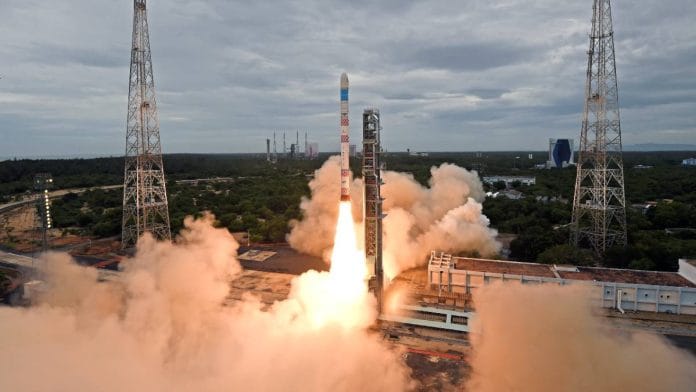New Delhi: For the first time in Indian space history, a defence PSU, Hindustan Aeronautics Limited (HAL), will get the complete technology to build an Indian rocket.
Indian National Space Promotion and Authorisation Centre (IN-SPACe), the Indian space regulator and promoter, said Friday that HAL won the transfer of technology (ToT) for the development of the Indian Space Research Organisation’s (ISRO) Small Satellite Launch Vehicle (SSLV) for a cost of Rs 511 crore.
“The SSLV technology transfer marks a pivotal moment in India’s transformative commercial space segment as this is one of the first instances of a space agency transferring complete launch vehicle technology to a company,” IN-SPACe chairperson Pawan Goenka said, adding that under the transfer of technology deal, HAL will have the capability to independently build, own, and commercialise SSLV launches.
Also Read: As China & US flex their satellite power, India plays catch-up in a cosmic game of thrones
SSLV tech transfer
In 2023, ISRO began taking bids from private players interested in constructing its SSLV. The aim was to open up the space business to private investment and attract private players into the launch market, following the lead of space agencies such as the National Aeronautics and Space Administration in the United States and the European Space Agency.
Initially, nearly 20 companies showed interest, but the final bidding was between Bengaluru’s Alpha Design Technologies, the leading firm of a consortium with Agnikul Cosmos and Walchand Industries, Hyderabad-based Bharat Dynamics, the leading company in a consortium with Skyroot Aerospace, Keltron, and BHEL, and Bengaluru’s Hindustan Aeronautics Ltd (HAL), which applied independently.
Rajeev Jyoti, director (technical directorate), IN-SPACe, said that since the launch vehicle system is multi-disciplinary, HAL will need to undergo “rigorous handholding and training under ISRO at both ISRO’s and the entity’s facilities”.
“This is aimed at realising the projected launch of two SSLVs from an Indian launch port. We are looking at completing this entire process within two years from the date of signing the technology transfer agreement,” Jyoti said.
SSLV rocket
SSLV is a three-stage launch vehicle. It has three solid propulsion stages and a terminal stage. The first three stages use solid propellants as fuel, with the terminal stage equipped with a liquid propulsion-based Velocity Trimming Module (VTM) and a payload adapter.
The VTM helps reduce the launch vehicle velocity when necessary, and the payload adapter connects the payloads to the rocket’s top stage.
The rocket has a diameter of 2.1 metres and a length of 34 metres. The lift-off mass is approximately 120 tonnes. SSLV is capable of ‘launch on demand’, which will help the government cater to the emerging small satellite launch services market.
The rocket has multiple satellite mounting options for nanosatellites, microsatellites, and minisatellites. It can also carry a single satellite, weighing up to 500 kilograms, to a planar orbit at a distance of up to 500 km—launched within six to eight missions every year.
Moreover, it can launch three different satellites ranging from 10 to 300 kilograms to a planar orbit up to 500 kilometres away. The rocket can carry payloads weighing up to 500 kg up to the low-Earth orbit (LEO) and up to 300 kilograms up to the Sun-synchronous orbit (SSO).
The rocket is different from the other generations of launch vehicles developed by ISRO—Satellite Launch Vehicle-3 (SLV-3), Augmented Satellite Launch Vehicle (ASLV), Polar Satellite Launch Vehicle (PSLV), Geosynchronous Satellite Launch Vehicle (GSLV), and GSLV Mark III. From SLV-3 to GSLV Mark III, they all catered to national developmental needs, enabling ISRO to develop and master critical technologies related to solid, liquid, and cryogenic propulsion systems.
Flexibility in accommodating multiple satellites, launch on demand, a low turnaround time (time taken to complete a process), minimal launch and infrastructure requirements, and a high industrial production rate are key features of a low-cost SSLV.
An integrated vehicle that can complete a launch within 24 hours, SSLV also has a minimum launch pad occupancy.
(Edited by Madhurita Goswami)
Also Read: A satellite bus, new green space propulsion system & tech collabs unveiled at Bengaluru Space Expo






